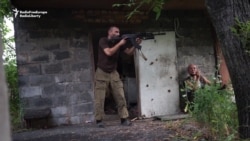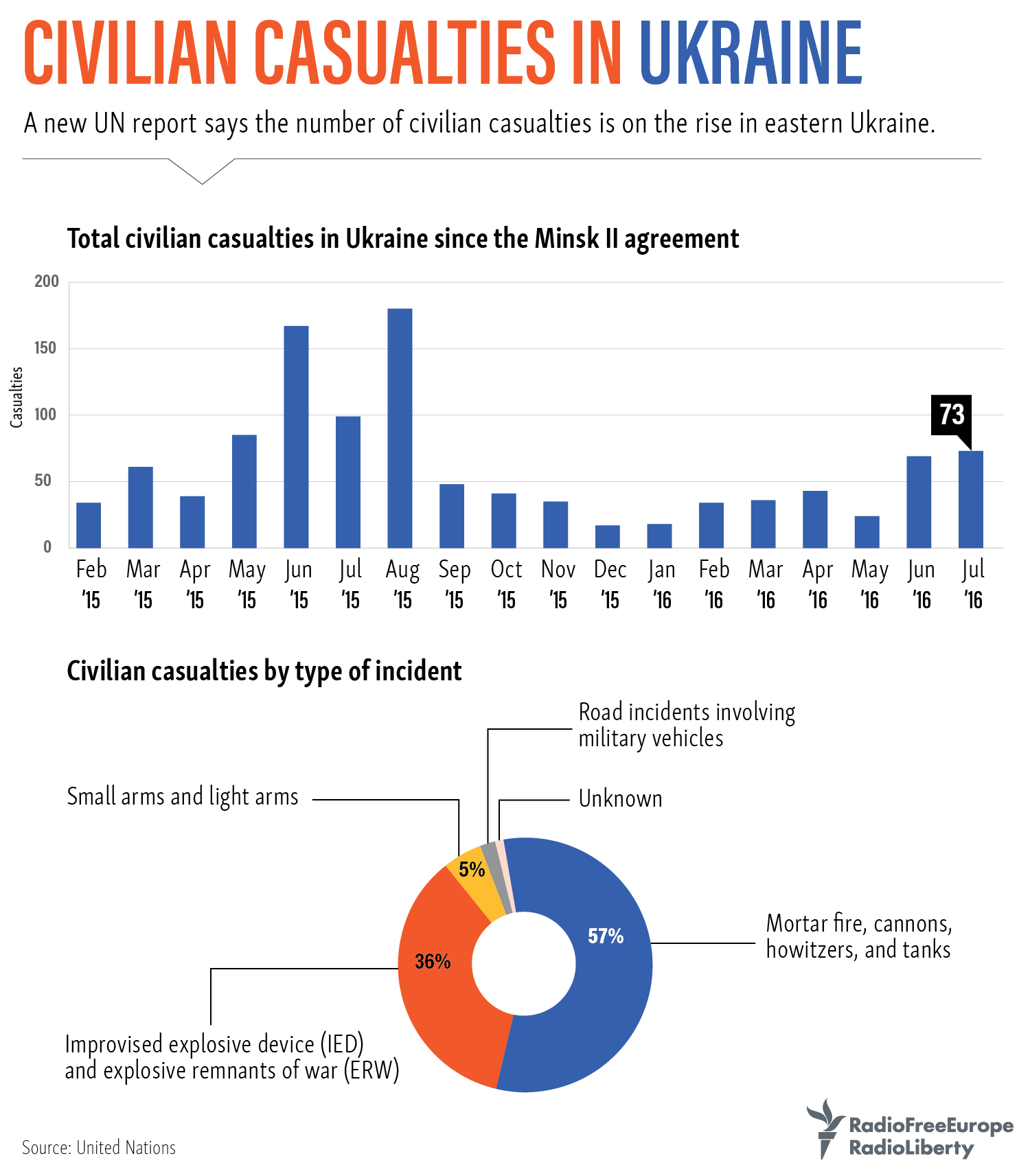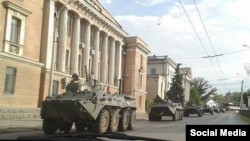MARYINKA, Ukraine -- Framed by a tiny cutout in the fortified bunker, this particular piece of no-man's land is tinted a blood-reddish orange by the setting summer sun.
It's hot as hell, and it's about to get hotter. When the sun goes down, the guns start blazing. And all that separates the men at their triggers is a grassy patch of land the size of a soccer field that is heavily mined. If you're a Ukrainian soldier here, you don't need binoculars to observe the enemy -- you just look in his direction.
It starts with a single shot from a Kalashnikov: Ziiip. Then another: Ziiip. And three more: Ziiip. Ziiip. Ziiip. Each shot whizzes dangerously closer. In the time it takes to boil an egg, the situation escalates as the rifles are joined by .50-caliber machine guns, mortars, and rocket-propelled grenades that explode with hollow thuds against the earth or cottages where the soldiers eat and sleep, showering everything with shrapnel. Within an hour, shells from howitzers and tanks -- and eventually surface-to-surface Grad missiles, whose name is Russian for "hail" -- begin pummeling the scarred steppe.
Reload. Fire. Repeat
The "disco," as the soldiers and the few residents left in this forsaken town call it, is in full effect. The relative calm that dawn brings seems a lifetime away. All are at the mercy of the darkness.
This is eastern Ukraine 28 months after the start of a conflict that once seemed unthinkable, and a year and a half after the signing of a second cease-fire deal, known as Minsk 2, that was supposed to bring lasting peace to this war-torn edge of Europe and reintegrate it with the rest of Ukraine.
But the armistice is unraveling fast as fighting between Ukrainian government forces and Russia-backed separatists has escalated to levels not seen since more furious phases of the conflict in the Donbas -- where the separatists hold parts of the Donetsk and Luhansk regions -- in 2014 and 2015. Casualties, both civilian and military, are mounting.
WATCH: Ukrainian government forces exchanged gunfire with Russia-backed separatists in the village on Maryinka during the night of July 28. (RFE/RL's Ukrainian Service)
War Footing
The number of civilian casualties recorded by the United Nations nearly doubled in June to 69, including 12 deaths, and rose again in July, when eight civilians were killed and 65 wounded.
"The escalation of hostilities and the accompanying civilian casualties in eastern Ukraine over the last two months are very worrying," UN High Commissioner for Human Rights Zeid Ra'ad al-Hussein said on August 3. "Civilians are once again having to flee to improvised bomb shelters in their basements, sometimes overnight, with increasing frequency -- the price of the cease-fire violations is too high for the women, men, and children in eastern Ukraine."
The UN said that 57 percent of those casualties were the result of "mortar fire, cannons, howitzers, and tanks" -- weapons banned under the Minsk deal.
When combatants and civilians are included, the toll of deaths documented by the UN Human Rights Office since the outbreak of war in April 2014 had reached 9,553 by July 31.
But the UN says the real number of casualties may be higher, and the International Crisis Group said in a July report that "there is little doubt that the death toll is significantly higher than either side admits."
The UN has urged all sides to respect the cease-fire provisions, to remove combatants and weapons from civilian areas, and to scrupulously implement the Minsk agreements -- successive cease-fire and settlement deals signed in September 2014 and February 2015.
But there are signs of both sides going back to a war footing: Kyiv is on high alert and has deployed special-forces units and battle-hardened battalions to the front, while Russia has reportedly amassed large amounts of military hardware in Crimea, the Black Sea peninsula it seized from Ukraine in March 2014.
After the leader of separatists in the Luhansk region, Igor Plotnitsky, was injured in an apparent assassination attempt on August 6, separatists were ordered to be on full combat readiness.
Peace Deal In Jeopardy
"The Minsk agreements have met their end," Vyacheslav Vlasenko, a commander of government forces who is known as "the Owl," told RFE/RL. Soldiers in his Donbas Ukraine unit, a volunteer battalion that split off and was brought under the control of the Ukrainian armed forces, nodded in agreement.
They are preparing for what they see as an imminent return to full-scale war -- something that is seen as a distinct possibility on both sides of the "demarcation line" in the Donbas.
"The situation remains tense, and at any moment it could break out and escalate into full-fledged clashes," Denis Pushilin, the leader of separatists in the Donetsk region, warned last week.
Puffing on a cigarette inside his Maryinka operating base, the raspy-voiced Vlasenko leaned over a situation map marked with blue and black ink and traces his finger over the locations where fighting is the heaviest -- these days, pretty much everywhere along the narrow frontier that separates his men from the Russia-backed fighters. In Maryinka, it is especially heavy near the bases of two old coal-mine slag heaps nicknamed "crocodile" and "tits" because of their shapes.
To highlight the recent escalation of violence, Vlasenko slid a casualty list for the past 49 days beneath a flickering lamp. It listed: 112 firefights; 45 wounded soldiers, including 19 from shrapnel and three from bullets; 18 troops with contusions; two with traumatic amputations; two with bone fractures; and one crushed to death by debris.
For the Ukrainian Army, July was the deadliest month since August 2015. At least 42 servicemen were killed and 181 wounded, according to statistics provided by Andriy Lysenko, military spokesman for President Petro Poroshenko's administration.
Some days the casualties were particularly bad. On July 19, Ukraine reported seven soldiers had been killed and 14 injured. On July 24, the military said six more died in clashes. On August 6, three servicemen died and four were wounded.
On the Internet, the Ukrainian military's daily situation map is lit up by explosion markers up and down the snaking 500-kilometer contact line, indicating pitched battles.
On the ground, unarmed monitors from the Organization for Security and Cooperation in Europe (OSCE) say both sides are violating the cease-fire on a regular basis. The group's nonpartisan, no-nonsense reports have shown that a steady increase in fighting began in June, with the number of cease-fire violations rising from dozens to hundreds daily and the use of heavy weapons on the front lines becoming more frequent.
The reports also paint a picture of a growing hostility toward members of the OSCE's Special Monitoring Mission to Ukraine (SMM) on the part of government troops and separatist fighters. In a July 30 report, the OSCE described members being surrounded by Donetsk separatist fighters who trained their rifles at them while one "made a 'cut throat' sign" and took photographs of their vehicles and the drivers. On August 2, a fighter in an unmarked uniform at a known Ukrainian military position chambered a round into his submachine gun, flicked off its safety, put his finger on the trigger, and aimed it at a monitor.
The OSCE mission has faced threats before, and has even had its members kidnapped. It has also faced criticism from both warring sides for not doing more.
The monitors acknowledge substantial limits to the effectiveness of their mission: They do not operate at night, meaning that much of the fighting is heard but not seen, and it is all but impossible to determine whether Russian soldiers and arms are crossing into Ukraine because they only have a mandate to observe at two border crossings.
At this point in the conflict, Vlasenko said, the OSCE was "useless."
A Deadly 'Game'
Before the war, Maryinka -- like many towns that have found themselves on the front line -- was a sleepy, rural collection of cottages. It lies just 28 kilometers west of Donetsk, the regional capital that is now a separatist stronghold. People like Alina Kosse, 58, raised their children and tended their gardens here, most living modest but unruffled lives.
"It was so peaceful and everyone was friendly," Kosse said while cooking a pot of borscht and a cabbage-wrapped meat-and-rice mixture to feed to Ukrainian soldiers passing through on their way to their forward positions.
For the past two years, Maryinka has been caught in the war's crossfire. The first heavy battles were fought here in July 2014, and the separatists controlled the town before the Ukrainian Army managed to regain its footing.
Much of the heart of the town was destroyed in the fighting.
The front line cuts right up against Maryinka's northern edge. On the other side is separatist-held Donetsk's Petrovskiy district.
Neighbors whose homes are a few minutes' walk apart haven't seen each other in more than two years: It can take as long as a transcontinental flight to cross a heavily guarded makeshift frontier bristling with fighters, checkpoints, tank traps, and land mines.
And the war remains so fluid here that sometimes it's hard to know which road belongs to whom. Possession of them can change daily, and one wrong turn can land you in enemy territory.
There is one road in Maryinka that nobody dares to tread. Dubbed the "road of death" and "snipers' alley," it dips and winds into a shallow valley overlooked by separatist positions perched atop slag heaps and on the upper stories of a line of buildings, making it easy to gun down anyone or anything that tries to pass.
Natasha, a friend of Kosse's who came over for a chat and a bite to eat, said the separatist snipers do not discriminate. "They assume whoever uses that road is a combatant, so they shoot to kill everything," she said. "It's like a game for them, to shoot at us like we're rats."
Fight And Sacrifice
Among some in Ukraine's government and many on the front line, the spike in fighting has fed a growing desire -- driven by anxiety about what Russia's military might do next, frustration over the failure of the Minsk deal to end the conflict, and anger at the mounting battlefield deaths -- to wrest back control of separatist-held territory by force rather than diplomacy.
"My soul hurts for each of the lives of our soldiers sacrificed for Ukraine," Viktor Muzhenko, the commander of Ukraine's armed forces, said after seven soldiers were killed on July 19. "There will be an adequate response."
Oleksandr Turchynov, chief of Ukraine's National Security and Defense Council, said the same day that if the situation continued to deteriorate he would consider imposing martial law.
President Poroshenko has since poured cold water on the idea, warning that international financial backers would freeze much-needed assistance for Ukraine -- which is struggling with economic troubles in addition to the war in the east and the aftermath of Russia's armed takeover of Crimea. But not since the conflict began in spring 2014 has the issue of martial law and greater security measures been so seriously discussed.
"This war is a bulls**t," one soldier, who asked that his name not be used because he did not want his commander to view him as insubordinate, said in English.
Switching to Russian, he said: "The Ukrainian Army is stronger than it was [at the start of the war], and we are ready to die if it is necessary. I say, let's make this sacrifice for our country, for its future."
Kyiv appears to be listening, at least with one ear.
In June, it put its strongest volunteer fighting battalions on a war footing, sending them back to the front lines to repulse separatist attacks.
Among them -- and deployed for the first time since its inception a year ago -- was Ukraine's 10th Brigade, which is comprised of a few thousand highly skilled soldiers from three units: Donbas Ukraine, the Aidar Battalion, and the 8th Battalion. All are positioned around Donetsk.
While they haven't made a big collective move, dozens of Ukrainian soldiers I spoke with said their commanders had been more aggressive than in recent months.
The Russia Factor
Inside the Donbas Ukraine post, a fly buzzed by the flickering light before getting stuck in dangling fly paper, a soldier with a boyish face and a Cossack-style Mohawk haircut scanned live cameras trained on separatist positions. Lighting up another cigarette, Vlasenko explained that he had been a more permissive commander as of late.
"If it's just small arms, like rifles, we don't shoot back [at the separatists]," he said. "But if it's rockets or something heavier, we respond with our own artillery. Or when I see that they are shooting at the homes of noncombatants, then I give the order to shoot at them. When they have killed or wounded one of our guys, I give the command to open fire with everything we've got."
Vlasenko added that his soldiers were allowed, in some cases, to take the first shot. "When we see them bring new equipment to the front, like they brought a tank yesterday, we open fire" to prevent them from using it, he said.
"We are not ruled by a desire to kill everyone standing on the other side of the line. Our aim is to stabilize the situation in Maryinka," he continued. But like the troops he commands, he is growing exasperated by the daily skirmishes that don't bring the end of the war any closer.
"Show [the journalists] our recent work," Vlasenko said to the soldier with the Mohawk, who switched from the live feed to a video shot on July 16 that shows Ukrainian artillery pounding what is said to be separatist positions.
When he closes his eyes, Vlasenko said, he daydreams about being given the order for all 69,000 Ukrainian troops Kyiv says are currently in the eastern war zone to push east to Donetsk and Luhansk -- and beyond. "I would like to see a parade of Ukrainian troops marching on Red Square," he says in deadpan tone.
Only then, he said, could Ukraine live in peace and he go back to what he was doing before the war: "lying on the sofa."
Dreams of Red Square aside, a major deterrent to any notion of a new Ukrainian offensive in the Donbas is the possibility that it would spur President Vladimir Putin's Russia -- which Kyiv and NATO say has poured money, soldiers, and weapons into Ukraine during the conflict and has a large force stationed just across -- to intervene with devastating effect.
Even without provocation from Kyiv, there are concerns in Ukraine that Russia could be gearing up for a new offensive. Crimean Tatar activists reported on August 7 that armed checkpoints were being hastily erected on the annexed peninsula and large concentrations of Russian hardware massed in northern Crimea, near mainland Ukraine. On the same day, Ukraine's border-guard service said that Russian authorities had blocked all entry to Crimea by road for several hours.
Ukraine got a deadly taste of what Russia's forces could do in the Donetsk region town of Ilovaysk in August 2014, when hundreds of Ukrainian troops were massacred after being surrounded, and again in February 2015 in Debaltseve, on a key highway between Donetsk and Luhansk. The battles dealt devastating blows to the Ukrainian military, in terms of human lives and morale, and bolstered the confidence of the Russia-backed separatists.
Russia and the separatists, meanwhile, may have their own motives for escalating the fighting now -- and their own reasons not to take it too far. In 2014, there were strong signs that Putin hoped to take control of a huge swath of southern Ukraine from the Donbas to Crimea and the Black Sea port city of Odesa -- an area that Russian leaders began to call Novorossia, or "New Russia" -- but that plan unraveled after it failed to catch on beyond Donetsk and Luhansk.
For Moscow today, disincentives for a major new offensive by the Russia-backed separatists include the prospect of stepped-up Western sanctions, fears of overstretching the military, and the ire Putin would face across much of the world if he ignited a full-scale war in Europe. Many analysts say that for now, at least, the Kremlin wants to use the conflict it helped whip up in the Donbas to destabilize Ukraine, bleed its economy, and keep it from getting too close to NATO and the European Union.
'Just Give The Order'
While Vlasenko holds the line in Maryinka and awaits orders, some are taking it upon themselves to push, ever so slowly, forward.
About 25 kilometers south of Maryinka, in sprawling field of wild grass outside the village of Solodke, the Aidar Battalion is now dug in just 300 meters from separatist positions after making a rare forward push eastward 1 kilometer in May.
They paid a steep price for the advance, as separatists pounded them with mortars and heavy artillery, destroying several vehicles and other equipment, as well as the warehouse that stored them. Commanders say they also lost soldiers in the push and in battles since, but they will not disclose how many for fear of appearing weak to their enemy.
A muscular middle-aged fighter who goes by the nom de guerre Musician -- a reference not to proficiency with an instrument but to his use of a grenade launcher beneath the barrel of his rifle -- said that those sacrifices would not be in vain, and that he and his comrades were eager to retake the separatist-held section of the Donbas by force.
"Just give the order," he said.
















